If you’ve never read a story or seen a movie or television show that includes a western American ghost town, I’d be surprised.
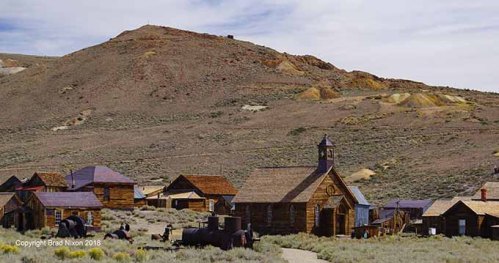
Ghost towns are evocative symbols of our transitory existence. Once lively with people, enterprise, even industry, they stand forlorn, abandoned, the effort and aspirations of the former inhabitants now crumbing to dust.
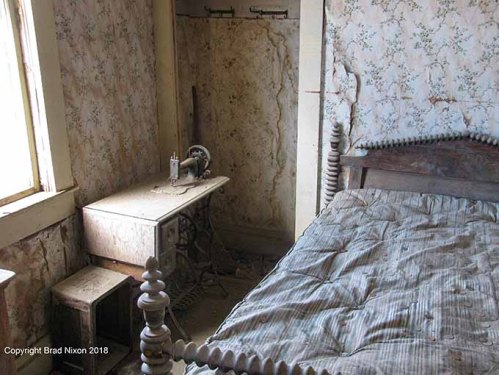
Ghost towns provide writers and filmmakers an enormous, literally blank slate. Without people, traffic or cell service to complicate things, they’re perfect settings in which to hide kidnappers, runaways, disaffected geniuses, bad guys, mad scientists, deposed political leaders, aliens, zombies — even the occasional ghost. Maybe the ultimate ghost town movie would have ’em all!
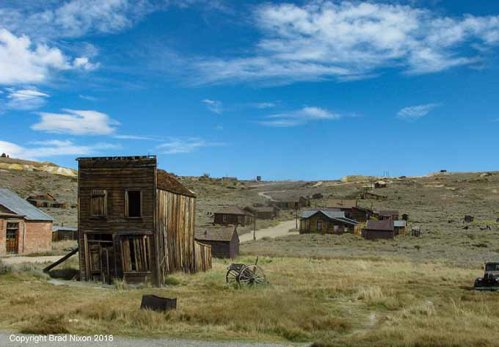
Although the American west may come first to mind when you hear the phrase, “ghost town,” there are ghost towns everywhere, on every continent. We may have the film industry to thank for the iconic place the ones in the western U.S. hold in our imagination. The arid landscape leaves the old towns weathering for decades without being overgrown by forest or washed away.
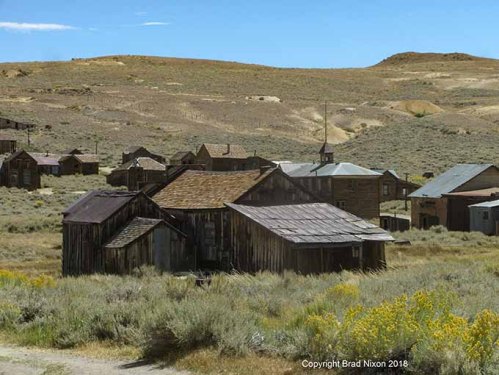
Recently, I visited one of the best-known and most picturesque Old West ghost towns: Bodie, California.
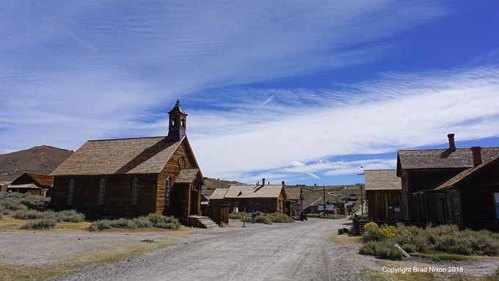
Like many ghost towns, Bodie owed both its ascent and fall to one commodity: gold.
After 1848, prospectors swarmed the hills, mountains, valleys and ravines of the western U.S. looking for gold, silver and minerals. Gold fever reached the barren Bodie Hills in 1876, when prospectors discovered significant gold deposits. The place didn’t just boom, it exploded. By 1879, there may have been 7,000 residents.
There were mines, stamp mills processing ore, three daily newspapers, a bank, railroad, volunteer fire companies, miners’ and mechanics’ unions, and fraternal organizations. In addition to shops and stores, hotels and boarding houses, Bodie had 65 saloons and TWO (!) churches.
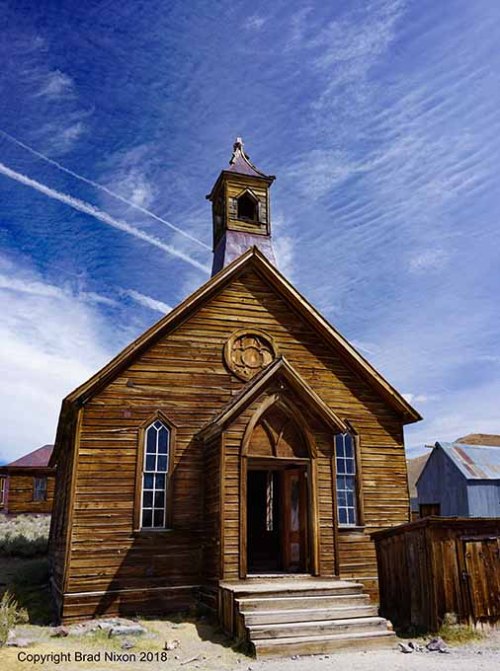
The hotels offered all the sophisticated comforts one could desire.
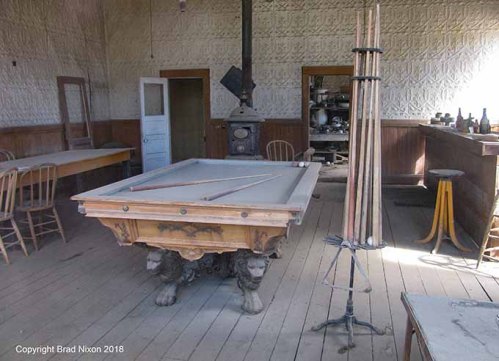
Shops were stocked with fashions from San Francisco, staples, canned goods and you can even see a snow sled on the left of the next photo.
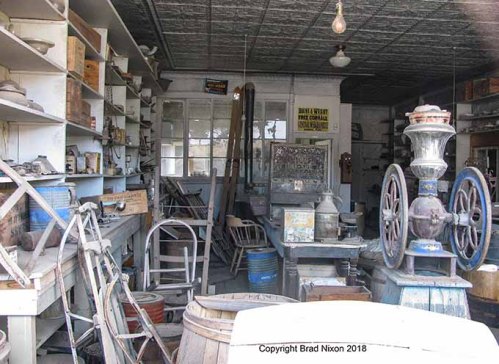
And then it all went away.
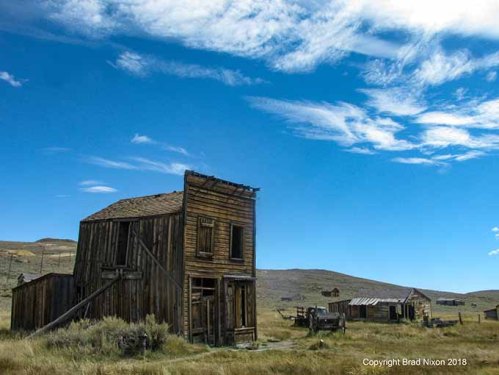
The gold began to play out, and new mining ventures beckoned across the mountains and deserts of the west. The prospectors, miners, card sharps, flim-flam men and women made tracks for the hot new properties, and Bodie dwindled. By 1890, the place was a shadow of the thriving gold rush city.
Die-hards hung on, as did one of the stamp mills. Some survived the ruinous depression at the end of the old century, the new century dawned, but Bodie languished and declined. With World War Two, the death knell: The stamp mine was closed as a non-essential industry.
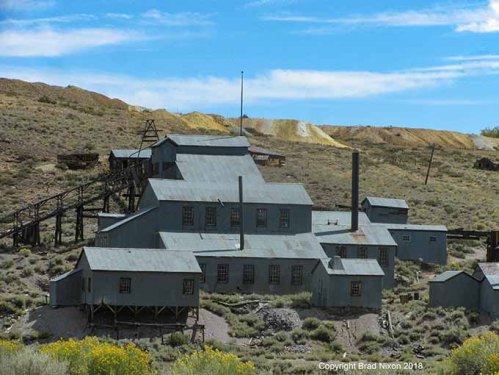
The remaining residents drifted away by 1942. The last teacher locked the doors of the schoolhouse, which had once boasted 600 students.
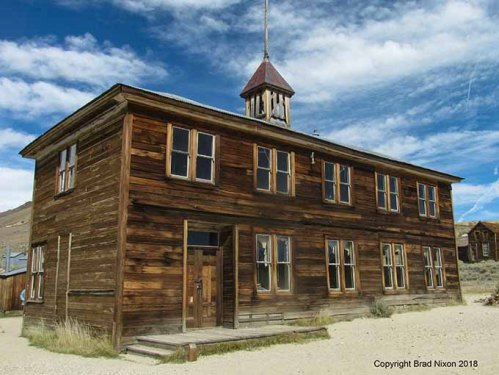
Peering through the dusty windows, you can still glimpse the desks, blackboards, and a map of Europe and the Middle East. Judging by the countries it shows, I estimate it must’ve been printed about 1940.
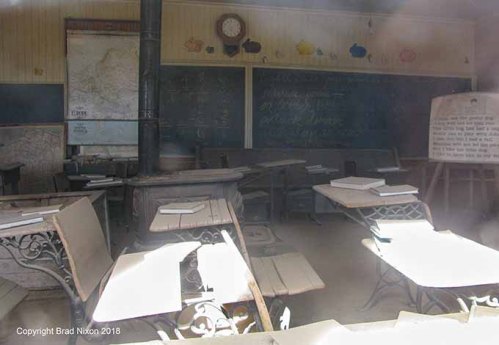
Bodie in the Present Day
The site is now a California State Park as well as a National Historic Site. The town has been left in a state of “arrested decay.” Of the hundreds that once comprised the town, 110 structures still stand. Bodie is a major attraction, and draws tens of thousands of visitors each year. Don’t let the presence of other humans deter you. Bodie is worth a visit.
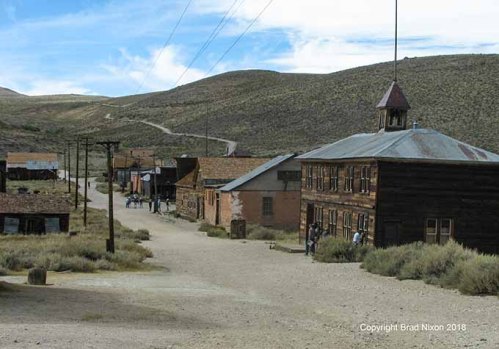
What distinguishes Bodie is that you roam freely, everywhere. You can confine your visit to strolling the length of Green Street and back.
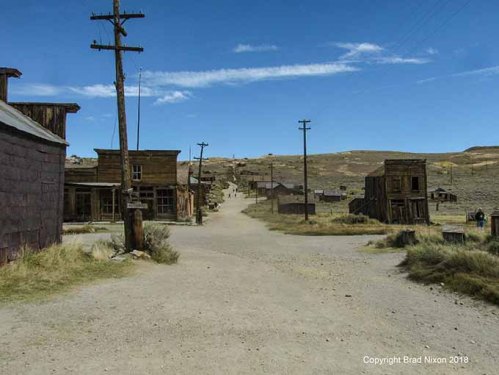
Or you can wander off along once-lively side streets that are now sagebrush-choked pathways. Reminders of an abandoned world are everywhere.
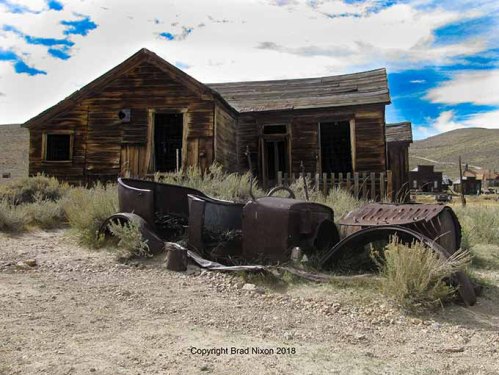
With every step, if you look down, you’ll find some artifact — a piece of broken crockery, some cast-off bit of iron work. Look through windows to see houses, shops, hotels just as they were left by the last inhabitant.

You can go into a handful of the buildings to get a closer look.
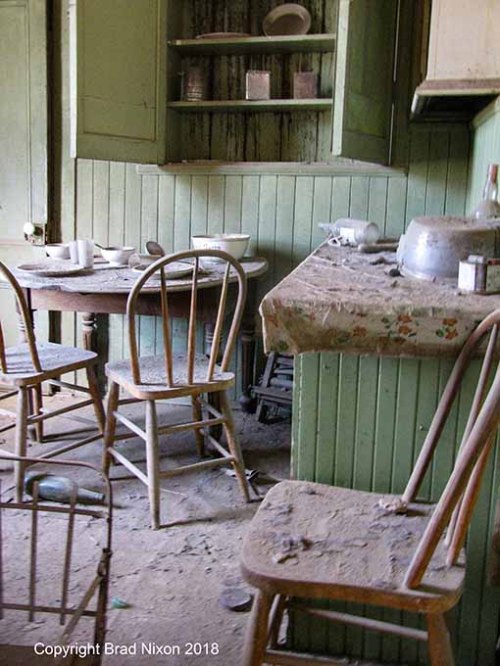
Visiting Bodie State Park
Bodie sits on the western slope of the mountains near California’s eastern border with Nevada. Turn off U.S. Route 395 32 miles north of the junction with California 120 at Lee Vining, near Mono Lake, or seven miles south of Bridgeport.
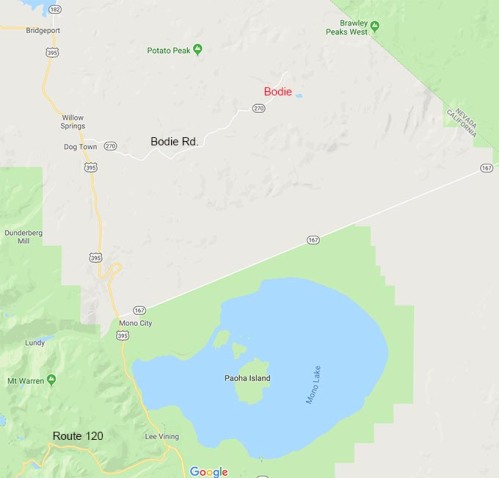
Turn east on paved Bodie Road, Route 270. The road is narrow, but picturesque. The pavement ends after 10 miles, leaving three miles of unpaved road that can be rough at times. Your Lamborghini won’t make it, but most conventional cars will.
It’s a state park, managed by the non-profit Bodie Foundation. There’s an $8 entrance fee per person. Pay it and smile. The person who collects from you is volunteering their time. Summer hours are 9 a.m. to 6 p.m. The park is open year-round, but snow often closes the road, restricting access to skis, snowshoes or snowmobiles. Visit the park website for more details.
Caveats
Be prepared for possible weather extremes. Due to its 8,375 foot elevation and situation on bare, exposed slopes, Bodie occupies an unusual subarctic climate zone. It is almost always colder than the valley below, sometimes significantly so. In the history of record-keeping, there has never been a month in which the low temperature did not drop below freezing at least once. The wind can be strong. Winter conditions can be brutally harsh.
The high altitude sun can be fierce, and the humidity is often low. Drink additional water. There are restrooms at the park, as well as drinking water.
Don’t forget the camera. “Photogenic” doesn’t begin to describe Bodie, under the western sky.
Have a favorite ghost town? Leave a comment.
Licensable, high resolution versions of a few photographs in this post, and select images from other Under Western Skies posts are available on Shutterstock.com. Click on the linked photos, or CLICK HERE to view the Underawesternsky photo portfolio.
© Brad Nixon 2018. Map © Google, with my emendations.

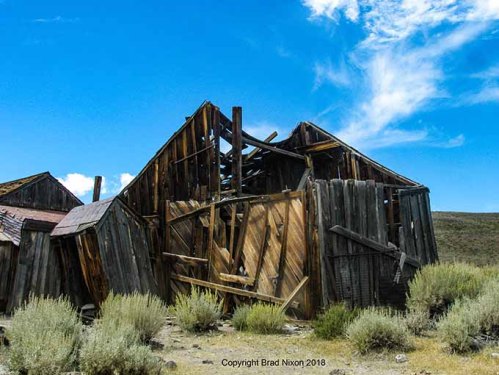
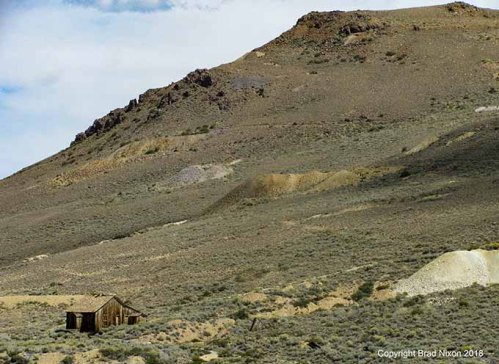
From your recent vacation? How cool!
Still, I’m wondering why people left so fast that there’s still bedding on the bed, tablets on the school desks and a pool table with balls and cue sticks on the table…was it maybe the Andromeda Strain??
LikeLike
By: Brian Doerter on September 28, 2018
at 10:51 am
Those are good questions. They occurred to us. I don’t know. Owners might have died, had their properties seized, or simply had no way to deal with what was left. The school’s probably an example of the latter. One can imagine the district not knowing what would become of the assets, and there’d be no market for them. There probably wasn’t another school within 30 miles. Nowhere to send ’em. I also consider it likely that some of that stuff was put there — staged — some number of years ago, for effect. I don’t know that. Take, again, the school. I’ll bet no student in a public school was allowed to leave without putting their books IN their desk before they left, but some number of those desks have (what appears to be the same) book on them. Possible set there for effect.
LikeLike
By: Brad Nixon on September 28, 2018
at 12:08 pm
That’s a lot of saloons for a small town! That said, the church is still in remarkably good shape, compared to the largely vanished saloons. Maybe the church wasn’t used as much as the saloons. 🙂
LikeLiked by 1 person
By: La Boheme on September 29, 2018
at 9:36 pm
Yep. Presumably the saloons held services on more than just Sunday.
LikeLiked by 1 person
By: Brad Nixon on September 29, 2018
at 9:59 pm
Nice photos of Ghost Towns. We have flooded Ghost Towns not too far from where I live. They were flooded to create the St Lawrence Seaway in the 1950s. Scuba Divers visit the lost villages still to this day and they brought up an old mill stone this year that was part of a grist mill.
LikeLike
By: shawnthompsonart on October 1, 2018
at 7:54 pm
That’s interesting. We’ve commented about the Seaway before, I think, but I’d never thought about what was flooded in creating it. Thanks for that observation.
LikeLike
By: Brad Nixon on October 1, 2018
at 8:15 pm
Of all the details I enjoyed, the carved lions serving as feet on the pool table have to be at the top of the list. I did wonder how much access you had inside the buildings. There don’t seem to be any visitor footprints on the floor there. I assume that some of the interiors are roped off to keep teh dust intact.
I tried to think of a true ghost town in Texas, and couldn’t. There certainly are towns that have disappeared, and which are located as “historic communities” on some maps, but they mostly just aren’t there. I finally decided it’s climate. Whole towns ‘go to ground’ here because of the heat and humidity, and old, abandoned buildings often are so covered with vines they’re nearly invisible.
In the hill country, it’s a little different, because the stone structures endure. Unfortunately, in some of the best-preserved towns, like Fredericksburg, they’re nearly hidden under a pile of tourists and kitsch.
LikeLiked by 2 people
By: shoreacres on October 2, 2018
at 4:02 am
Here’s a note I left out of the post that will appeal to you: There’s debate about what qualifies as a “ghost town.” Self-styled purists insist that GENUINE ghost towns were abandoned by their populations, not driven out by nuclear accidents (Pripet, Russia); flooding by dams (innumerable); or war (countless), etc.
And I’ll bet you’re right that the Texas environment has been hard on ghost towns. It’s difficult enough to keep occupied structures standing amidst tornadoes, snow, ice and everything else that sweeps across the state!
LikeLike
By: Brad Nixon on October 2, 2018
at 10:28 am
But the worst? heat and humidity. Mildew and rot abound around this place. That’s why fence posts that aren’t stone or metal are cedar. It’s the only wood that will stand.
LikeLike
By: shoreacres on October 2, 2018
at 10:41 am
Of course. I lost sight of the fact that you live in the place that made it necessary to invent air conditioning before humans could live there in any numbers. The vastness and range of the Texas climate(s) is hard to encompass in any single impression. It’s not just a *place*.
LikeLike
By: Brad Nixon on October 2, 2018
at 10:49 am
I loved those lion feet too. So many wonderful details of the past in this town. I look forward to returning.
LikeLike
By: myeclecticcafe on October 2, 2018
at 10:30 am
An excellent lesson of history with great pictures.
I’ve never seen completely abandoned cities in Europe. All of them were semi-abandoned. Every time, at least one house was inhabited. I think the evacuated city of Matera, Italy, will be my first experience. It’s in my list.
Brad, thank you for the excursion.
LikeLiked by 1 person
By: Victor Tribunsky on October 5, 2018
at 10:16 am
You’re welcome. Technically, one person “lives” at Bodie at any one time when it’s not deep winter: a park ranger on duty, who lives in one of the old structures that’s been maintained. I saw the ranger on duty when we were there, but didn’t have a chance to speak with him. It would be an interesting conversation.
LikeLike
By: Brad Nixon on October 5, 2018
at 10:19 am
Yes, it would. It’s interesting what he feels at night there?
LikeLiked by 1 person
By: Victor Tribunsky on October 5, 2018
at 10:27 am
I didn’t mention it, but an enormously popular activity at Bodie are organized visits at night to photograph the town and the sky by moonlight. They’re by reservation only, and I believe they are booked long in advance.
In the town of Bishop, where we stayed, I met a local man who’s an amateur photographer, and he schedules his time around visits up to the Bristlecone Pines area in a long quest to capture a perfect shot of the Milky Way, often waiting until 2 a.m. to make his exposure. As you can appreciate, all those mountain ranges are popular venues for night sky photography, hundreds of miles from any city lights.
LikeLiked by 1 person
By: Brad Nixon on October 5, 2018
at 10:50 am
It’s no wonder. The air is clear.
LikeLiked by 1 person
By: Victor Tribunsky on October 6, 2018
at 9:30 am